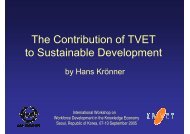Learning for Life, Work and the Future Initial ... - Unesco-Unevoc
Learning for Life, Work and the Future Initial ... - Unesco-Unevoc
Learning for Life, Work and the Future Initial ... - Unesco-Unevoc
You also want an ePaper? Increase the reach of your titles
YUMPU automatically turns print PDFs into web optimized ePapers that Google loves.
<strong>Learning</strong> <strong>for</strong> <strong>Life</strong>, <strong>Work</strong> <strong>and</strong> <strong>the</strong> <strong>Future</strong> Participants’ Papers Page 79<br />
• Use of occupational unit st<strong>and</strong>ards as a framework<br />
<strong>for</strong> assuring quality of VET <strong>and</strong> VET provision<br />
• Integration of business <strong>and</strong> entrepreneurial skills so<br />
as to motivate VET graduates towards job creation<br />
<strong>and</strong> self-employment<br />
• Introduction of target-oriented training focusing on<br />
those with limited access to VET, e.g. girls, women,<br />
youths <strong>and</strong> rural populations.<br />
9. Challenges<br />
• How to h<strong>and</strong>le <strong>the</strong> large dem<strong>and</strong> <strong>for</strong> sociallyoriented<br />
training <strong>for</strong> <strong>the</strong> in<strong>for</strong>mal sector <strong>and</strong><br />
unemployed youth in a bid to promote <strong>the</strong> private<br />
sector.<br />
• How to develop concepts <strong>for</strong> organising <strong>and</strong> developing<br />
small <strong>and</strong> medium enterprises.<br />
• How to address <strong>the</strong> insufficiently-supported sectors<br />
such as agriculture, hotels <strong>and</strong> tourism, service <strong>and</strong><br />
finance, mining <strong>and</strong> food processing.<br />
• How to change <strong>the</strong> attitudes of providers.<br />
• How to develop a qualifications framework that has<br />
horizontal <strong>and</strong> vertical linkages <strong>and</strong> qualifications<br />
definitions <strong>for</strong> easy portability, both locally <strong>and</strong> in<br />
<strong>the</strong> region.<br />
• How to integrate entrepreneurship training in VET,<br />
since most of <strong>the</strong> entrepreneurship courses are currently<br />
organised outside <strong>the</strong> framework of regular<br />
technical training.<br />
• How to ensure financial sustainability <strong>for</strong> VET<br />
providers, particularly considering that Vocational<br />
Training is also a social function <strong>and</strong> cannot be<br />
financed <strong>and</strong> managed through training fees alone.<br />
24 NDUNGURU, Bernadetta (United Republic of Tanzania):<br />
Integrated Training <strong>for</strong> Entrepreneurship Promotion (INTEP) Reaching <strong>the</strong><br />
Target Groups in <strong>the</strong> In<strong>for</strong>mal Sector<br />
1. Introduction<br />
As in many o<strong>the</strong>r African countries, <strong>the</strong> <strong>for</strong>mal labour<br />
market in Tanzania is small <strong>and</strong> decreasing even more<br />
as a consequence of <strong>the</strong> economic <strong>and</strong> social adjustments<br />
during <strong>the</strong> last fifteen years. The <strong>for</strong>mal labour<br />
market is profoundly imbalanced as 45% of <strong>the</strong> total<br />
population is under 15 years of age. More than<br />
500,000 young people are entering <strong>the</strong> job market each<br />
year while <strong>the</strong> number of jobs created in <strong>the</strong> modern<br />
wage sub-sector may perhaps be less than 30,000 per<br />
annum. In 1990/91 <strong>the</strong> in<strong>for</strong>mal sector (IS) offered<br />
employment <strong>for</strong> 2.4 million people, which was more<br />
than twice <strong>the</strong> number employed in <strong>the</strong> <strong>for</strong>mal sector<br />
(government, parastatals <strong>and</strong> private firms). Only<br />
2.1% out of <strong>the</strong> total number of operators had <strong>for</strong>mal<br />
training.<br />
Formalised training <strong>for</strong> <strong>the</strong> <strong>for</strong>mal sector is a national<br />
requirement; however, it has only very limited relevance<br />
to <strong>the</strong> employment chances of <strong>the</strong> majority of<br />
people who generally have no access to training. As a<br />
supplement to <strong>for</strong>mal training, integrated non-<strong>for</strong>mal<br />
training can help to qualify various target groups to<br />
acquire technical, business <strong>and</strong> communication skills,<br />
but it must be job- <strong>and</strong> market-related, short <strong>and</strong><br />
inexpensive.<br />
2. Training Approaches<br />
The Vocational Education <strong>and</strong> Training Authority<br />
(VETA) in Tanzania has adopted a new training system,<br />
<strong>the</strong> Competency-Based Education <strong>and</strong> Training<br />
(CBET) system. The CBET approach enhances<br />
effectiveness <strong>and</strong> efficiency of VET through:<br />
• A comprehensive approach that enables adaptation<br />
of training to <strong>the</strong> needs of <strong>the</strong> labour market. For<br />
example, entrepreneurship training <strong>and</strong> cross<br />
cutting skills are an integral part of training delivery<br />
to allow translation of technical skills into business<br />
<strong>and</strong> to ensure <strong>the</strong> desired market-oriented<br />
competency.<br />
• Modularised training, which allows <strong>the</strong> trainee to<br />
choose specific separate training units according to<br />
<strong>the</strong> skills needed <strong>for</strong> employment, or to go <strong>for</strong> <strong>the</strong><br />
full cycle of units. In <strong>the</strong> first case, <strong>the</strong> successful<br />
participation of each unit is certified separately, in<br />
<strong>the</strong> second case, <strong>the</strong> trainees will receive <strong>the</strong> full<br />
trade recognition after <strong>the</strong> completion of all <strong>the</strong><br />
required training units. Within this process <strong>the</strong><br />
existing <strong>for</strong>mal training curricula are being<br />
modularised.<br />
• Non-<strong>for</strong>mal training whereby training packages are<br />
specifically designed <strong>for</strong> selected target groups <strong>the</strong>y<br />
address, by choosing existing training units of <strong>the</strong><br />
curriculum of <strong>the</strong> respective occupation or developing<br />
tailor-made training programmes. The timing<br />
of non-<strong>for</strong>mal training is adapted so as to fit into <strong>the</strong><br />
trainees’ commitments as a business operator or<br />
employee, i.e. in evening classes. The successful<br />
participation in a course is certified accordingly.<br />
Lately, VETA has been increasing its offers of non<strong>for</strong>mal<br />
training, especially <strong>for</strong> commercial trades<br />
<strong>and</strong> to a lesser extent <strong>for</strong> technical skills.





